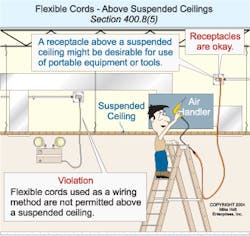All questions and answers are based on the 2005 NEC.
Q. Can a 15A, 125V receptacle be located above a suspended ceiling?
A. Sure. Receptacles are permitted above a suspended ceiling, but a flexible cord isn't [400.8(5)]. Why install a receptacle above a ceiling if the flexible cord isn't permitted in this space? Because the receptacle could be used for a portable tool or equipment; it just can't be used for cord-and-plug equipment fastened in place (Figure at right).
Q. Is a splice permitted in a panel?
A. Yes. Splices and taps can be installed in cabinets, cutout boxes, or meter socket enclosures if the splices or taps do not fill the wiring space at any cross section to more than 75% (312.8).
Q. Can an AFCI-protected circuit leave the bedroom of a dwelling unit and supply other receptacle or lighting outlets?
A. Sure. There is no Code requirement limiting the use of AFCI-protected circuits to bedroom outlets.
Q. I'm wiring a showroom at a car dealership. We installed the receptacle outlets 16 inches (to center) above the floor, but the electrical inspector says it's a Code violation because there is a door along this wall, which opens into the service garage area (a classified location). He says this is the case even if the door has a closure on it and always remains closed. He also states this classification is the same for any room with a door that goes into the garage area, unless the air ventilation or air pressure exceptions apply to the space. Is my installation in violation of the NEC?
A. Yes. The area adjacent to a classified location, up to 18 inches above the floor, is classified as a Class I, Division 2 location, unless mechanically ventilated at a rate of four or more air changes per hour, or when walls or partitions effectively cut off the adjacent area [511.3(A)(3) and 511.3(B)(1)].
Q. An electrician installed a two-wire 20A receptacle circuit (12 AWG) with six 15A, 125V duplex receptacles. He wired the receptacles as feed through (daisy chain) using the four screws on each device. The inspector would not accept the installation and said that he had to splice the wires and leave a pigtail, which then connected to only two screws of the receptacle. Is this an NEC requirement?
A. No. Only the grounded conductor of a multiwire branch circuit is required to be pigtailed [300.13(B)]. Even on a multiwire circuit, the ungrounded conductors are not required to be pigtailed. In all cases, where equipment grounding (bonding) conductors are used, they are required to be pigtailed [250.148(B)].
Q. The 2005 NEC now requires all 15A and 20A, 125V receptacles located within 6 feet of the dwelling unit laundry sink to be GFCI protected. Does this apply to a single receptacle on a dedicated branch circuit for the washing machine?
A. Yes. See 210.8(A)(7). However, there are no exceptions similar to those for GFCI protection of receptacles in garages and unfinished basements [210.8(A)(2) and (5)].
About the Author

Mike Holt
Mike Holt is the owner of Mike Holt Enterprises (www.MikeHolt.com), one of the largest electrical publishers in the United States. He earned a master's degree in the Business Administration Program (MBA) from the University of Miami. He earned his reputation as a National Electrical Code (NEC) expert by working his way up through the electrical trade. Formally a construction editor for two different trade publications, Mike started his career as an apprentice electrician and eventually became a master electrician, an electrical inspector, a contractor, and an educator. Mike has taught more than 1,000 classes on 30 different electrical-related subjects — ranging from alarm installations to exam preparation and voltage drop calculations. He continues to produce seminars, videos, books, and online training for the trade as well as contribute monthly Code content to EC&M magazine.
